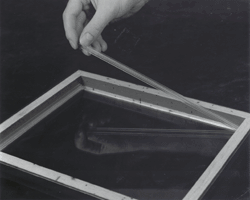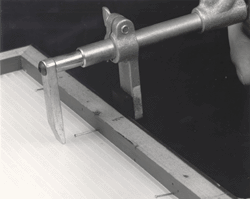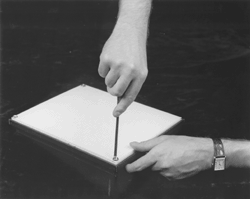Framing Works of Art on Paper – Canadian Conservation Institute (CCI) Notes 11/9
(PDF Version, 1.06 MB)
CCI Note 11/9 is part of CCI Notes Series 11 (Paper and Books)
Why Frame?
There are three main reasons for framing a work of art: to protect it, to display it more easily, and to enhance its aesthetic appearance.
What to Frame
Almost any single-sheet paper artifact can be framed: prints, drawings, watercolours, manuscripts, letters, posters, small maps, silhouettes, and photographs. However, framing manuscripts on parchment, vellum, palm leaves, papyrus, or birch bark is more complex and may require the attention of a professional conservator
Choosing a Frame
The actual choice of frame and style of moulding is a matter of personal preference. The frame should have a rabbet deep enough to accommodate the thickness of a mat, a backing board, and a glazing material (about 2 cm in total). These should fit snugly but not tightly in the frame. Metal clip-together frames are not always deep enough to accommodate all three components.
The technique by which the artifact is sandwiched between two sheets of glass or between glass and board held together with clips is not recommended. It offers little protection from dust or atmospheric pollution, which can still intrude through the exposed edges, and it puts unnecessary pressure on the artifact.
Re-using Original Frames
Examine an original frame carefully for damaged or missing moulding, lost gilding, loose joints, warping, etc. before re-using it. Replace any glass that is chipped, broken, or brittle.
Spacers
In some cases, it may be necessary to return a work of art to its original frame without a window mat (for example, if the rabbet is not deep enough to accommodate one). Hinge the artifact to a sheet of acid-free matboard in the conventional way (CCI Notes 11/5, Matting Works on Paper), and insert a spacer to separate the artifact from the glazing material. Spacers can be made from strips of acid-free matboard attached to the rabbet with 3M #415 double-sided tape, Framespace polyester strip, or Inner Space acrylic strip, which can be cut to any length and inserted into the frame (Figure 1).
Note: A spacer may not be deep enough to prevent an unstable artifact, such as one with a friable image (i.e., pastels, chalk, charcoal), cracked or flaking paint (i.e., gouache), or planar distortions (i.e., cockling, buckling of the paper or board support) from touching the glazing material. Such contact may result in pigment transfer or in partial adhesion. This method is therefore only recommended for flat, stable works of art.

Glazing Materials
The suitability of various types of glazing material is discussed in CCI Notes 11/3, Glazing Materials for Framing Works on Paper.
Backing Boards
For additional protection, a neutral pH backing board, which is not part of the mat itself, should be placed in the frame behind the mat. The choice of material will sometimes depend on the depth of the rabbet (Figure 2).

What to Use
- Acid-free, 100% rag-content matboard (4-ply).
- Cor-X, Coroplast, Poly-Flute: extruded twin wall plastic made of polypropylene.
- Fome-Cor, Artcor: surface layers made of paper and central foam layer made of polystyrene.
What Not to Use
Many materials commonly used as backing boards often contain harmful acids and resins that may eventually migrate to the artifact. Therefore, masonite, corrugated cardboard, wood, and other materials that are not acid-free are not recommended.
Securing the Backing Board
Secure the backing board using finishing nails (inserted with a brad pusher or tack hammer) or glazer's points (Figure 3), taking care not to split the moulding.

If the rabbet is not deep enough to insert a backing board, the board can be attached to the back of the frame with screws and cup washers (Figure 4).

Sealing the Frame
To prevent the intrusion of dust and airborne pollutants, seal the frame with adhesive tape across the point where the backing board meets the frame. Brown Kraft tape is commonly used, but gummed linen tape is better because it is more stable. If the backing board is extruded plastic, these tapes will not adhere very well; however, pressure-sensitive cloth tapes such as Filmoplast SH tape and University Products Sealing Tape work well.
Hanging Devices
Various methods for hanging paintings are discussed in CCI Notes 10/3, Systems for Paintings, and CCI Notes 10/4, Environmental and Display Guidelines for Paintings. Many of these methods will also apply to framed works on paper. If picture wire is to be used, it should be strong enough to support the weight of the frame. A more secure method is to insert picture hooks into the wall and attach the frame's screw eyes to them.
Lighting
Do not attach light fixtures to frames. These lights produce excessive light levels, tend to create a "hot spot" on the picture, and contribute to the fading of dyes and pigments. For recommended light levels, see CCI Technical Bulletin Nº 5, Environmental Norms for Canadian Museums, Art Galleries and Archives; CCI Notes 2/1, Ultraviolet Filters; and CCI Notes 2/3, Track Lighting.
Suppliers
Acid-free (neutral pH or buffered) matboard:
- local art and drafting supply stores
- frame shops
Acid-free (neutral pH) gummed linen tape:
- Kruger Fine Papers Ltd;
- University Products of Canada;
- Frameguild Mouldings Ltd
Framing tapes:
- Vanguard Mouldings;
- Opus Framing Ltd;
- ArcProtec Inc.; local art suppliers
Filmoplast SH:
- Artistic Woodwork
Sealing tape:
- University Products of Canada
Spacers:
-
Inner Space:
Framing Experience -
Framespace:
Artistic Woodwork
Backing boards:
- E.M. Plastics and Electric Products;
- Cadillac Plastics;
- local plastics suppliers
Framing supplies (hooks, wire, brad pusher, tack, hammer, etc.):
- Artists' suppliers;
- frame shops;
- hardware stores;
- Talas
Addresses of Suppliers
- ArcProtec Inc. / Archival Conservation Resources
(Distributor for Conservation Resources International)
2847-C Sandalwood Drive
Ottawa, Ontario
K1V 7P4
Telephone: 613-523-9260 - Artistic Woodwork
5830 Cooper Avenue
Mississauga, Ontario
L4Z 1Y3
Telephone: 416-890-1234 - Artistik Inc.
9991 Saint-Vital Blvd.
Montreal North, Quebec
H1H 4S5
Telephone: 514-323-3075
Branches: Calgary, Vancouver - University Products of Canada
6535 Millcreek Drive, Unit #8
Mississauga, Ontario
L5N 2M2
Telephone: 416-858-7888
Toll-free: 1-800-667-2632
fax: 416-858-8586 - Cadillac Plastics
(Dayco Canada)
91 Kelfield Street
Rexdale, Ontario
M9W 5A4
Telephone: 416-249-8311
Branches: Dorval, Vancouver, London, Halifax, Edmonton, Calgary - Carr McLean
461 Horner Avenue
Toronto, Ontario
M8W 4X2
Telephone: 416-252-3371
1-800-268-2123 (toll-free in Ontario except area code 807)
1-800-268-2138 (toll-free in other areas) - E.M. Plastics and Electric Products
430 Norfinch Drive
Downsview, Ontario
M3N 1Y4
Telephone: 416-665-6111
1-800-268-1252 (toll-free)
or
8010 Devonshire
Montreal, Quebec
H4P 2K3
Telephone: 514-731-6411
1-800-361-1432 (toll-free) - L'étude
9 Ste. Catherine Street East, suite 103
Montreal, Quebec
H2X 1K3
Telephone: 514-844-7054 - Frameguild Mouldings Ltd
230 Supertest Drive
Downsview, Ontario
M3J 2M2
Telephone: 416-661-9333 - Framing Experience
Branches across the country except in Montreal and Eastern Canada
Head Office: Burlington, Ontario
Telephone: 416-825-2145 - Kruger Fine Papers Ltd
3295 Bedford Road
Montreal, Quebec
H3J 1G5
Telephone: 514-731-3561 - Opus Framing Ltd
1360 Johnston Street
Granville Island
Vancouver, B.C.
V6H 3S1
Telephone: 1-800-663-1255 (toll-free) - La Papeterie St-Armand
950 Ottawa Street
Montreal, Quebec
H3C 1S4
Telephone: 514-874-4089 - Singer Encadrements Inc.
6220 Somerled
Montreal, Quebec
H3X 2B3
Telephone: 514-482-0243 - Talas
568 Broadway
New York, N.Y.
10012 U.S.A.
Telephone: 212-219-0770
fax: 212-219-0735 - Vanguard Mouldings
(Distributor for Process Materials)
222 Supertest Road
Downsview, Ontario
M3J 2M2
Telephone: 416-661-0111
1-800-268-1220 (toll-free)
Bibliography
-
Canadian Conservation Institute. Environmental and Display Guidelines for Paintings. CCI Notes 10/4. Ottawa: Canadian Conservation Institute, .
-
Canadian Conservation Institute. Glazing Materials for Framing Works on Paper. CCI Notes 11/3. Ottawa: Canadian Conservation Institute, .
-
Canadian Conservation Institute. Matting Works on Paper. CCI Notes 11/5. Ottawa: Canadian Conservation Institute, .
-
Canadian Conservation Institute. Track Lighting. CCI Notes 2/3.Ottawa: Canadian Conservation Institute, .
-
Canadian Conservation Institute. Ultraviolet Filters. CCI Notes 2/1.Ottawa: Canadian Conservation Institute, .
-
Clapp, Anne F. The Curatorial Care of Works of Art on Paper. 4th revised edition. New York: Nick Lyons Books, .
-
Doloff, Francis W. and Perkinson, Roy L. How To Care for Works of Art on Paper. 3rd edition Boston: Museum of Fine Arts, .
-
Ellis, Margaret Holben. The Care of Prints and Drawings. Nashville: AASLH Press (American Association for State and Local History), .
-
Glaser, Mary Todd. Framing and Preservation of Works of Art on Paper. New York: Sotheby Park Bernet Inc., [n.d.].
-
Guide to Conservation Mounting and Framing of Works of Art on Paper. London: Sotheby's, [n.d.].
-
Holm, S., editor, Le montage et l'encadrement des oeuvres sur papier. Quebec: Ministère des Affaires culturelles, .
-
Lafontaine, Raymond H. Environmental Norms for Canadian Museums, Art Galleries and Archives. CCI Technical Bulletin Nº 5. Revised edition, Ottawa:Canadian Conservation Institute, .
-
National Gallery of Canada. The Care of Prints and Drawings, with Notes on Matting, Framing and Storage. Ottawa: National Gallery of Canada, .
-
Nuttall, Prudence. Picture Framing for Beginners. New York: Watson-Guptill, N.Y. .
Copies are also available in French.
Texte également publié en version française.
© Government of Canada,
Cat. Nº NM95-57/11-9-1995E
ISSN 0714-6221